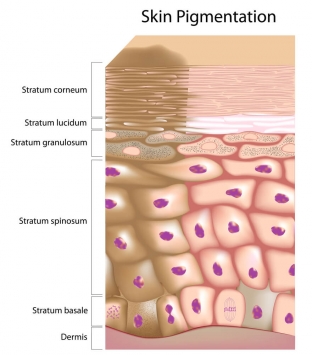Until recently, the removal of certain types of hyperpigmentation presented significant difficulties, since & nbsp; with dermal or mixed occurrence, for example, melasma, after laser peeling remained & nbsp; the risk of developing post-inflammatory hyperpigmentation, and other methods failed to penetrate so deeply into the skin. Today, cosmetologists use in their practice laser removal of age spots using the & nbsp; fractional skin rejuvenation. For this, an erbium laser is used. Read about the features of its effect on age spots at estet-portal.com.
What makes laser hyperpigmentation removal effective
One of the methods of laser removal of hyperpigmentation – this is the effect on the pigment spot with broadband pulsed light (photorejuvenation). The effect is achieved due to the fact that the melanin contained in the cells vigorously absorbs this spectrum of rays, resulting in the selective destruction of cells with excess accumulated pigment. The method is effective when exposed to hypermelanoses, which are located superficially or lie down at the epidermal level.
For deep localization of the pigment spot, laser peeling is used, while the use of an erbium laser is preferable.
 The principle of the Er:YAG 2940 nm laser on the skin is that the water contained in the cells absorbs the laser beam and instantly evaporates. In this case, the cell does not have time to warm up and transfer heat to neighboring tissues, so that post-peeling inflammation is excluded. The thickness of the epidermis averages about 100 microns, and the laser beam penetrates simultaneously to a depth of about 4 microns, which makes it possible to dose its work very accurately. Laser removal of pigment spots occurs evenly, layer by layer. Since part of the epidermal cells is evaporated already during the laser peeling procedure, the peeling & nbsp; of the skin occurs only approximately on the third day after the removal of pigmentation, and it is not very pronounced, it passes quickly.
The principle of the Er:YAG 2940 nm laser on the skin is that the water contained in the cells absorbs the laser beam and instantly evaporates. In this case, the cell does not have time to warm up and transfer heat to neighboring tissues, so that post-peeling inflammation is excluded. The thickness of the epidermis averages about 100 microns, and the laser beam penetrates simultaneously to a depth of about 4 microns, which makes it possible to dose its work very accurately. Laser removal of pigment spots occurs evenly, layer by layer. Since part of the epidermal cells is evaporated already during the laser peeling procedure, the peeling & nbsp; of the skin occurs only approximately on the third day after the removal of pigmentation, and it is not very pronounced, it passes quickly.
If the pigment spot lies deep in the dermis or has a mixed localization, a fractional thermolysis procedure is recommended. The essence of the procedure is that an erbium laser (Er:YAG 2940 nm) creates microchannels in the skin that reach the desired depth of the dermis. At the same time, their walls do not coagulate, the cells do not overheat, the surrounding tissues do not become inflamed, interstitial fluid can be freely released through the microchannels, as well as excess pigment from the intercellular spaces.
Which procedures can laser pigmentation removal be combined with
In case of hypermelanoses with pigment deep in the dermis or pigment spots of mixed localization, it is recommended to combine laser peeling with fractional thermolysis to achieve the maximum effect. This combined procedure allows you to deal with such pigmentations that are not amenable to other methods of treatment. In some cases, a good result is achieved by combining photorejuvenation with fractional thermolysis (for example, in the case of mixed melasma).
In parallel with laser procedures, the patient is prescribed carotenoids, proanthocyanidins, drugs that inhibit melanogenesis.
When performing laser removal procedures for hyperpigmentation to patients be sure to remind you of the need for constant use of sunscreen cosmetics.
It is necessary to warn the patient that even with complete removal of hyperpigmentation and achieving a stable remission, there is a possibility of regression of the pigment spot. The reason for such a regression may be contact with active solar radiation or hormonal fluctuations in the body.







Add a comment